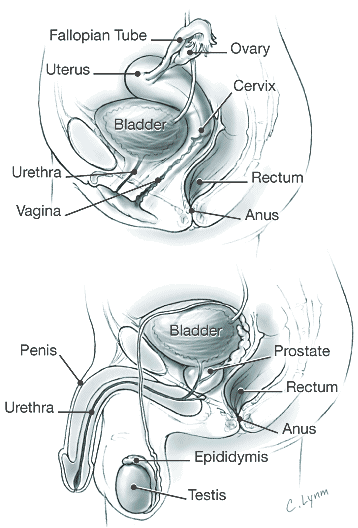
|
| SEARCH MEDICAL LIBRARY |  |
|
› Home » Medical Library Medical Library 
JAMA Patient Page:
Screening and Prevention of Sexually Transmitted Diseases Most people who have an infection usually will experience at least one or two noticeable symptoms. However, many people who have a sexually transmitted infection caused by chlamydia might not have symptoms and might not know they are infected. This is why it is important to get tested or "screened" if you are at risk for coming in contact with someone who is infected.

What are Sexually Transmitted Diseases?
Sexually transmitted diseases (sometimes referred to as "STDs") are diseases that are usually spread through sexual activity. They include chlamydia, gonorrhea, genital herpes, HIV/AIDS, and syphilis. There are many serious health problems associated with STDs. These include pelvic inflammatory disease in women (a serious infection of the uterus and fallopian tubes) and epididymitis (inflammation of the epididymis — a coiled tube by the testis) in men. These complications from STDs can cause infertility and increase the risk for some cancers.
Symptoms of an STD Infection:
Remember that many people with STDs may not experience symptoms.
The Importance of Screening
Anyone who is sexually active should have regular checkups for STDs. If it is determined that you are infected, you can receive medication to treat the infection and prevent spreading the disease to others by sexual contact or to your baby, if you are pregnant.
Lowering Your Risk of STD Infection
If you are sexually active and are unsure if your partner is infected with an STD (or is in contact with someone else who is infected), or if you have more than one sex partner, you should:
For More Information
Inform Yourself
To find this and previous JAMA Patient Pages, go to the Patient Page Index on JAMA's Web site at www.jama.com. Previous JAMA Patient Pages were published on the following STDs: syphilis on July 26, 2000, genital herpes on September 9, 1998, and chlamydia on August 12, 1998.
Sources: National Institute of Allergy and Infectious Diseases, Centers for Disease Control and Prevention, The AMA Complete Guide to Women's Health, The AMA Family Medical Guide.
Brian Pace, M.A., Writer (JAMA 2001; 285:118)
Published in JAMA: January 3, 2001
The JAMA Patient Page is a public service of JAMA and the AMA. The information and recommendations appearing on this page are appropriate in most instances; but they are not a substitute for medical diagnosis. For specific information concerning your personal medical condition, JAMA and AMA suggest that you consult your physician. This page may be reproduced noncommercially by physicians and other health care professionals to share with patients. Any other reproduction is subject to AMA approval. To purchase bulk reprints, call (718) 946-7424. |
|
 #) 
|
Copyright © 2003-2004 Medem, Inc. All Rights Reserved.

 Printer-friendly format
Printer-friendly format